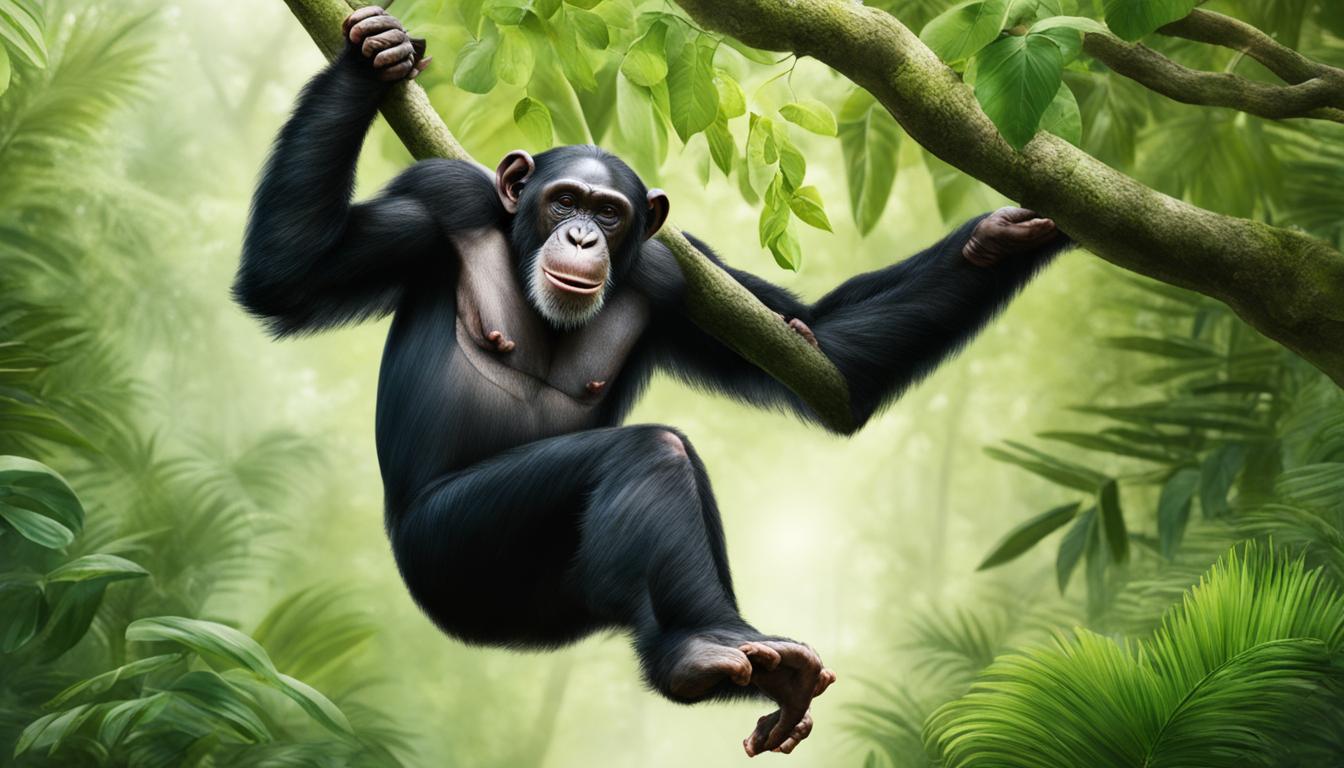Chimpanzee behavior is a fascinating and complex subject, encompassing both their natural behavior in the wild and their behavior when housed in captivity. Studying chimpanzee behavior in the wild provides valuable insights into their social lives, communication, intelligence, tool use, territorial behavior, and reproductive behavior. Conversely, understanding captive chimpanzee behavior is crucial for ensuring their welfare and designing appropriate enclosures and enrichment activities.
Chimpanzee Behavior in the Wild
In their natural habitat, chimpanzees exhibit a complex social structure, with females forming strong bonds and males often forming alliances for dominance. This social structure is crucial to their survival and plays a significant role in their daily lives.
Chimpanzees communicate with one another through a variety of vocalizations, gestures, and facial expressions. Their communication system is intricate and allows them to convey different messages and emotions. This communication is essential for maintaining social harmony and coordinating group activities.
Studies have shown that chimpanzees display remarkable intelligence. They are capable of problem-solving, critical thinking, and tool use. In fact, chimpanzees are known to use tools like sticks and rocks to extract food, crack nuts, or even fish for termites from their mounds. This demonstrates their cognitive abilities and adaptability in using their environment to their advantage.
Chimpanzees also exhibit territorial behavior, defending their ranges against other groups. These boundaries are crucial for securing valuable resources, such as food and mates. Interactions between different chimpanzee groups can be fierce and may involve aggressive displays or even physical confrontations.
Furthermore, chimpanzee reproductive behavior involves complex mating strategies and intricate social dynamics. Males compete for the opportunity to mate with females, and females have the choice in selecting their mates. This dynamic influences the social hierarchy within the group and contributes to the overall genetic diversity of the population.
Understanding wild chimpanzee behavior provides invaluable insights into their biology, social interactions, and evolutionary history. It allows us to appreciate their complex nature and enables conservation efforts to be more effective in protecting their natural habitats.
Image:
Captive Chimpanzee Behavior
When housed in captivity, chimpanzees may exhibit different behaviors compared to their wild counterparts due to the constraints of their environment. The design of zoo enclosures and the provision of environmental enrichment play a crucial role in promoting the well-being of captive chimpanzees. Without adequate stimulation and opportunities for natural behaviors, they may become more sedentary, prone to obesity and other illnesses. Abnormal behaviors, such as stereotypic pacing or self-injury, can also emerge in captive individuals, highlighting the importance of ensuring their psychological well-being.
To ensure the best possible welfare for captive chimpanzees, it is essential for zoo enclosures to mimic their natural habitat as closely as possible. These enclosures should provide sufficient space for social interactions, climbing, and foraging activities. Environmental enrichment, such as the inclusion of climbing structures, puzzle feeders, and foraging opportunities, can help stimulate the chimpanzees mentally and physically.
Enrichment activities can include:
- Introducing novel objects
- Providing opportunities for problem-solving
- Offering a variety of food and feeding techniques
- Creating opportunities for social interactions
It is crucial to regularly evaluate and modify enrichment programs to ensure they continue to engage and challenge the chimpanzees. By promoting natural behaviors and mental stimulation, zoos can contribute to the psychological well-being of captive chimpanzees.
Furthermore, close monitoring of the chimpanzees’ behavior is essential to identify any potential signs of distress or abnormal behaviors. The presence of stereotypic pacing, self-injury, or other repetitive behaviors can indicate a lack of psychological well-being and enrichment. Timely interventions, such as altering the enclosure or providing additional enrichment, can help alleviate such behaviors and improve the chimpanzees’ overall welfare.
| Abnormal Behaviors | Possible Causes | Recommended Interventions |
|---|---|---|
| Stereotypic Pacing | Lack of stimulation and environmental complexity | Providing opportunities for exploration and social interaction |
| Self-Injury | High levels of stress or frustration | Identifying and addressing the underlying causes of stress and frustration |
| Oral Stereotypies | Inadequate or monotonous diet | Offering diverse and challenging feeding techniques |
By prioritizing captive chimpanzee welfare and ensuring the provision of appropriate enclosures and environmental enrichment, zoos can contribute to the overall well-being and conservation of these incredible animals.
The Role of Zoos in Chimpanzee Conservation
Chimpanzees face numerous threats in the wild, including habitat loss, the bushmeat trade, and poaching. This emphasizes the critical role that zoos play in the conservation of these magnificent creatures. Zoos contribute to chimpanzee conservation in multiple ways, from preserving genetic diversity through captive breeding programs to raising public awareness about the importance of their protection.
One of the key contributions of zoos is their involvement in captive breeding programs. These programs help maintain and increase the genetic diversity of chimpanzee populations, safeguarding their long-term survival. By carefully managing breeding pairs and promoting successful reproduction, zoos play a crucial role in ensuring the sustainability of captive chimpanzee populations.
Additionally, zoos have a unique opportunity to educate the public about chimpanzee conservation. By providing opportunities for people to observe and learn about these incredible animals up close, zoos can inspire a greater appreciation for chimpanzees and their conservation needs. Through exhibits, educational programs, and outreach initiatives, zoos raise awareness about the threats faced by chimpanzees in the wild and the importance of protecting their natural habitats.
“Zoos have a responsibility to not only provide a safe and enriching environment for the animals in their care but also to act as ambassadors for their wild counterparts.” – Jane Goodall
By fostering a connection between visitors and chimpanzees, zoos can encourage support for conservation efforts. People who have the opportunity to witness the intelligence, social bonds, and unique behaviors of chimpanzees are more likely to become advocates for their conservation, taking action to support initiatives that protect their habitats and combat threats such as deforestation and the bushmeat trade.
Ultimately, the role of zoos in chimpanzee conservation extends beyond the boundaries of their physical premises. They contribute to global efforts by partnering with conservation organizations, participating in research projects, and supporting initiatives that directly impact chimpanzees in the wild. By working collaboratively, zoos can maximize their conservation impact and help secure a brighter future for chimpanzees.
In summary, zoos play an integral role in chimpanzee conservation by preserving genetic diversity, raising awareness, and inspiring action. Their captive breeding programs and educational initiatives contribute to the long-term survival of chimpanzee populations and help combat the various threats they face in the wild. By providing opportunities for people to connect with these incredible creatures, zoos foster a sense of responsibility and support for their conservation. Together, we can make a difference in protecting chimpanzees and their natural habitats.

Bridging the Gap Between Wild and Captive Chimpanzee Behavior
Researchers are constantly seeking ways to bridge the gap between the behaviors exhibited by chimpanzees in the wild and those confined to captivity. One promising tool that has been developed is the integrated Enclosure Design Tool (EDT), which enables zoos to compare the behavior of their captive chimpanzees with wild-type behavioral profiles. By doing so, zoos can make evidence-based modifications to enclosures, promoting more natural behaviors and enhancing the welfare of the chimpanzees.
The focus of the EDT is to replicate the mechanical behavior of a tropical forest, providing captive chimpanzees with an environment that closely resembles their natural habitat. This involves incorporating structures that mimic the climbing opportunities, the shades of light and darkness, and the diverse textures and materials found in the wild, allowing the chimpanzees to engage in behaviors that they would naturally exhibit in their unpredictable environment.
The physical and mental challenges that chimpanzees face in the wild are also integrated into the design of captive enclosures. This includes the inclusion of puzzle feeders, hidden food sources, and novel objects that stimulate their problem-solving abilities and engage their curiosity. These challenges are essential for the chimpanzees’ well-being, as they provide both physical exercise and mental stimulation.
By utilizing the integrated Enclosure Design Tool, zoos can create environments that meet the physical and mental needs of captive chimpanzees, bridging the gap between their behaviors in the wild and in captivity. This not only improves the welfare of the chimpanzees but also enhances the educational value for visitors, who can observe the animals engaging in more natural behaviors. The continuous research and advancements in enclosure design and environmental enrichment contribute to the conservation and preservation of this species, ensuring a better future for chimpanzees.
The Changing Role of Zoos in Chimpanzee Conservation
The role of zoos in chimpanzee conservation is undergoing a significant transformation, driven by a deep commitment to the welfare of these remarkable creatures and the promotion of a greater understanding of their natural behaviors. Zoos have emerged as powerful advocates for conservation, providing a unique opportunity for visitors to connect with chimpanzees and learn about the critical need to protect their species.
Visitor education is a key aspect of the changing role of zoos in chimpanzee conservation. By showcasing these magnificent animals and their complex behaviors, zoos can inspire and educate the public, fostering a sense of empathy and a desire to take action. Through captivating exhibits, interpretive signage, and educational programs, zoos empower visitors to become ambassadors for conservation, spreading awareness and supporting vital initiatives.
To further optimize the welfare of captive chimpanzees, zoos are increasingly collaborating with universities and researchers. These partnerships enable the translation of scientific knowledge into practical recommendations, ensuring that enclosure design, enrichment activities, and management practices align with the specific needs and natural behaviors of chimpanzees. One groundbreaking collaboration in this domain is the development of the Integrated Enclosure Design Tool (EDT), which enables zoos to assess and enhance the well-being of their chimpanzees through evidence-based modifications.
What are the differences in chimpanzee hunting behavior in the wild versus in captivity?
In the wild, chimpanzees hunting strategies involve working together to track and capture small prey like monkeys. They use complex communication and coordination. In captivity, hunting behavior is rarely observed as they are often provided with pre-prepared food. Captive chimps may exhibit foraging behavior instead of hunting.
How do chimpanzees’ hunting behaviors differ in the wild versus in captivity?
In the wild, chimpanzee hunting strategies involve coordinated group efforts to capture prey, such as monkeys or small mammals. They use a combination of stealth, communication, and teamwork to secure a successful hunt. In captivity, chimpanzees may exhibit different hunting behaviors due to limited opportunities and resources.







